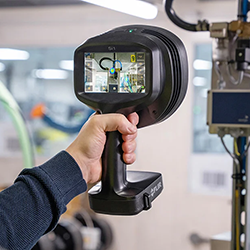Is Brett Favre Running Your Supply Chain?
The importance of 3PLs being prepared for the current and future technological battleground of the warehouse: Addressing the need to integrate and orchestrate all of the work being completed by utilizing automated technology, including robots
As a die-hard Packers fan, it's been 30 years since I've worried about a quarterback. While your average Bears fan suffers from PTSD after watching 30 different quarterbacks over the same period, I've been unconsciously lulled into thinking we will always have a Hall of Fame QB under center. Brett Favre joined the Packers in 1992, the very same year I drew up the industry's first modern WMS architecture. Since then, we have made halting and incremental progress, building on aging standards that calcify how operations are driven inside the warehouse.
In our industry, we fell asleep; Brett Favre is still under center. We need to move on. The warehouse has become the heart and soul of the supply chain, where inventory, demand, suppliers, distributors, customers, value-added services, and labor all meet to orchestrate increasingly complex processes to serve customers.
We need a modern, creative, and flexible quarterback, er, I mean WMS/WES, to run today's increasingly complex offense…ugh…increasingly complex warehouse. Think no code/low code warehouse optimization. In the next two to five years, we will see profound transformations in warehouse operations.
The Technological Battleground of the Warehouse
Let's talk about real life, life in the modern world of supply chain. The floor is now the technological battleground of the warehouse. It houses sortation, mechanized picking, high-speed conveyors, autonomous mobile robots (AMRs), and various other picking technologies. Each system comes with its own system and logic, which may or may not align with the rest of the facility. Warehouses need an intelligent system that can orchestrate the entire operation - that's where the WES - or Warehouse Execution System - comes into play. WES, one of the most confusing terms in warehousing, has been bantered about to describe all kinds of concepts. But let me summarize. WES provides coordination and optimization across automation subsystems that share data to drive maximum ROI - essentially the quarterback of the warehouse.
WES originally began by coordinating low-level warehouse control system elements. Most WES-only vendors' scope of visibility is limited to this level of the system. But, in addition to data feeds from low-level equipment, the ideal WES should provide a truly higher-level dynamic orchestration for customers. It should work downward to optimize the order fulfillment flow by digesting massive amounts of data from order feeds, the progress of waves and SLA commitments, and other higher-level data. It should also provide end-to-end warehouse visibility and updates so your warehouse can run at peak efficiency.
The solution should be a modern composable platform that enables orchestration across various devices and systems on the warehouse floor - enabling WES to reach the pinnacle of functionality. This high-speed streaming data engine should provide a comprehensive, bird's-eye view of your warehouse operations and enable data-driven decisions.
Streaming event data allows you to perceive every aspect of your operation, from low levels to the highest, in ways that allow you to take systematic action. Being able to see all the warehouse elements, such as order volumes, labor placement, and moment-to-moment structural pressures, is crucial in making informed decisions - and informed decisions increase ROI.
This modern solution should take the pulse of your sortation system, the health of conveyor belts, the automation availability status of different stations, order volumes, and SLAs, and provide all of this data to make better operational decisions and scale your business. It should help you see everything from incoming order volumes to blocked sensors as the WES expands your scope of influence to every part of the order fulfillment operation.
Maybe Jordan Love is the answer; we need more "unit and volume testing" in the Packers offense for sure. I do know in today's digitally demanding landscape, we should focus on interoperability and composability to meet modern warehouse management needs to provide customer choice, agility, scalability, and satisfaction. It's the only path forward for companies to reach maximum ROI, and fast.
---
Mark Fralick is a software expert known as the "founding father of modern WMS architectures." He is also Chief Technology Officer for Softeon, the only tier-1 warehouse management system (WMS) provider focused on optimizing warehouse and fulfillment operations, with the capability to run the most complex 3PL warehouses in the world. Softeon is laser-focused on customer results, with a 100% track record of deployment success. He also loves the Packers. For more information, please visit www.Softeon.com.
Featured Product

